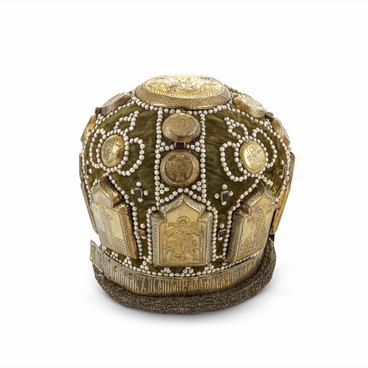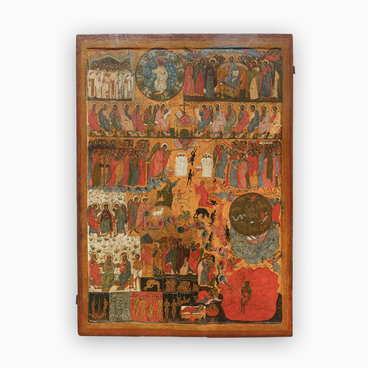The Greek word Aër, or “vozdukh” in Russian, means a veil. In the Orthodox liturgical tradition, it is one of the woven coverings for sacred vessels used in the Divine Liturgy.
Byzantine veils could reach two meters in length. The tradition of making large veils came to Rus from Byzantium and was practiced until the 17thcentury. “Savior Not Made by Hands with Saints” is one of the largest medieval Russian veils. It was made in 1389. Its dimensions are 123 by 220 centimeters.
In modern liturgical practice, the Aër is usually an embroidered veil, with the image of a cross in the middle. The size of modern veils varies from 40×60 to 80×110 centimeters.
In general, such veils are distinguished by the presence of liturgical and contributory inscriptions. Traditionally, inscriptions in Church Slavonic were placed along the edges: “Righteous Joseph…”, “In the tomb with the body…”, “Let all mortal flesh keep silence…”, and “Take and eat…”. Images could be painted or embroidered with threads and beads.
The most popular image depicted on veils was the composition “The Entombment of Christ”.
The veil “The Entombment of Christ” on display at the Museum of Russian Heritage shows the Mother of God supporting the head of Christ and two myrrh-bearing wives on the left of the tomb. On the right, behind the tomb, John the Theologian, Joseph of Arimathea and Nicodemus stand bowing down.
In the background there are two angels with ripidia in their hands. A ripidion is a liturgical utensil in the form of a metal or wooden fan on a long handle. Both sides feature an image of a six-winged seraph in a circle, in a rhombus or in a star.
A cross rises in the center of the veil, and a staircase is depicted next to it. Above the cross in the clouds is the God of Hosts with the Orb in His hand. From above, the Holy Spirit descends in the form of a dove in shining rays.
The images on the veil were made mainly with spun gold and silver threads attached with stitches made with a thinner thread (using the following seams: “serrated”, “berry”, “rows”, “square” and others). Silk threads were also used. The faces and exposed parts of the bodies were embroidered with twisted silk using the “satin” seam, with shading. The background is golden in the center and red along the edges.
Sewing church covers and veils was considered a
God-pleasing craft. Among peasants and in the upper strata of society, a girl
was taught needlework from childhood. Complex iconographic compositions and
inscriptions required the participation of professionals.


